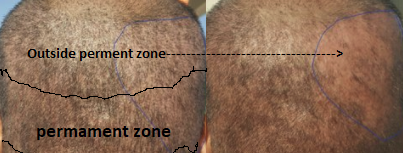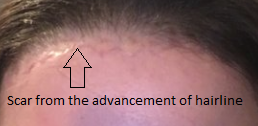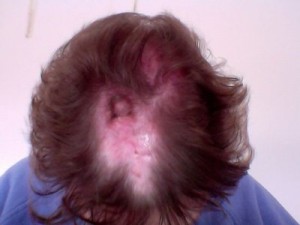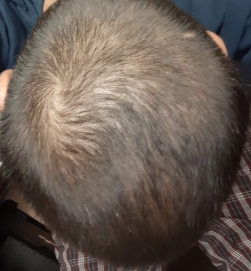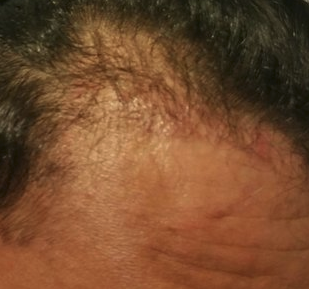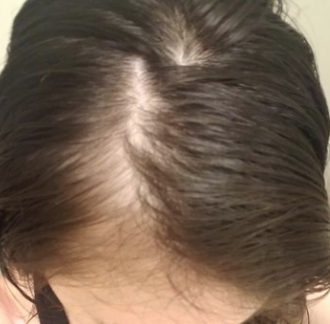It is highly likely that you were over-harvested with FUE grafts unless you had an unusually high donor density. Ask your doctor what was your donor density prior to the FUE. From the pictures, it shows that the FUE was taken outside the permanent zone so many of the grafts may not live your lifetime. Over time, as you continue to bald, the FUE scars in the balding area outside the donor area will start to show and become a problem. The bald area could be the result of shock loss or vascular damage in the donor area from the extensive FUE. Only time will tell
Hair loss is not uncommon following a hairline advancement surgery in a female which will reveal the scar that was made at the time of the surgery. Matter of fact, this can happen with almost any facial surgery and I have seen this in many face lift and brow lift female patients. A hair transplant is the only solution for this which will bury the scar in the transplanted hair and the hairline can be moved further forward at the same time.
Dutasteride is a drug that is not approved for use against hair loss by the FDA. This man might consider abandoning both finasteride and dutasteride until he gets control of his health.
Suffering from intense sides from dutasteride from tressless
You do indeed have terrible crusting resulting from poor post-operatieve washing techniques. An FUE is treated just like a regular hair transplant with regard to the recipient area, but the donor area has open wounds which require daily washing with soap and water. An FUE is treated just like a regular hair transplant with regard to the recipient area, but the donor area has open wounds which require daily washing with soap and water. Within 3 days of surgery, you can resume full activities, heavy exercises if you wish. The recipient area requires daily washes as well to keep the recipient area free of crusts. I generally recommend the use of a sponge and supply my patient with a surgical sponge to fill with soapy water and press on the recipient area daily. By repeating this daily, all crusts can be washed off without any fear of losing grafts. IF any crust is present, use a Q tip and dip it into soapy water, and roll it on the crusts and that will lift them off without dislodging them, but never rub them, just roll the Q tip on the recipient crust. I like to see no evidence of any crusting in the recipient area and the crusts from the donor area gone in 3-4 days with daily washing. To get the crusting off because you did not follow this routine, you need to leave the shampoo on your hair for 10 minutes and as the crust become water logged, then will come off with gentle finger action over a number of days doing just what I suggested.
I have a question about Finasteride sides. I just started on a dosage of 1mg every other day, and so far have only taken it twice. The first day I noticed nothing out of the ordinary. The second day I took it, I was able to masturbate twice during the day, but the orgasm seemed somewhat dull and the semen shot out in a more watery way. And that night, I wasn’t able to get an erection at all despite trying. It feels unlikely that just 2mg taken over a three-day period could cause side-effects, so I wonder if it’s anxiety-related from reading about the side-effects. But of course it’s scary not to feel able to get an erection. How do you recommend dealing with it? Should I stop the medication until I return to ‘normal’, and if these are early side-effects, how long before 2mg would leave my body completely? Thanks.
I don’t know the answer, but the watery semen is a known common side effect. If this continues, either stop it or speak with your doctor about these sides. The drug is usually out of the body within 2-3 weeks after stopping it because it fixes to various tissues in the body even after it clears the blood stream within a day.
These pigments came in all flavors, some with metals, some non-organic pigments and some organic pigments. This industry is not regulared by the FDA, We provide our own unique pigments and have done commercial analysis of some of the pigment in use, very frightening to find out that many of the pigments are purchased from art stores?
I have seen the sexual side effects appear after a man has been on the drug for months or years. The incidence reported of 2-4% was reported over a 5-year period of time, but I agree with you, that it may be more than the reported numbers. Most people, when they get off the drug, will find that the sexual side effects disappear in a month or two.
11 months of finasteride use, but side effects are becoming increasingly real from tressless
LLLT is an option that really does not do much although because so many people use it and are vested in the effort, the reports are not very accurate. I studied patients with LLLT treatments in two forms. The first was an expensive LLLT machine which I offered at no charge to my patients but required them to submit to photography follow-up. The second modality was a Laser Hat. I also required them to submit to photography follow-up. All of the follow-up showed me no a single result that was objective by good photography. Some patients thought that they were better, but things like hair length and products used on the hair change your view of your own hair.
You should certainly see a doctor and get a diagnosis in the case that these pimples reflect an infection. Of course, that is the problem when you go to Turkey, there is no follow-up of problems but you should be able to find a doctor in the UK that will see you
I would need to examine you and find out what classification of hair loss you have. For example, do you have some frontal recession? At this age, the best treatments are finasteride with minoxidil. I would try it for a full year. A hair transplant at your age, would catch you in a transition to balding and just make it worse. There is never a rush to do a hair transplant because so many young men who rush are sorry that they did it.
Hair transplants are certainly not for everyone. Most women with miniaturization in the back and sides of the head (80% of women who are losing hair fall into this category), men under 25, people who don’t have evident balding in some part of the head, other diseases that are present (mal-nutrition, terminal diseases, other systemic diseases that may interfere with your results or increase your risk from a medical point of view, or taking medications causing hair loss that you must take. unrealistic expectations, most commonly inadequate finances to cover the costs that reflect that hair loss in men is a progressive process.
I had 2000 grafts into my two corners and now, 8 months later, it all looks thin. Is this a failure of the surgery?
Certainly, if each side received 1000 grafts, then this is not reflective of such a number of grafts. I would return and see your doctor as most doctors will ‘make things right’ and redo the hair transplant assuming that you still trust the doctor
Sometime we doctors don’t come up with a solution for thinning in women, even with extensive blood testing. A simple cosmetic approach is the use of Scalp Micropigmentation, something that I performed on my own family with great success. The cosmetic approach works well for men and women when surgery or drugs just will not help the situation as shown here: here: https://scalpmicropigmentation.com/thinning-hair-gallery/

